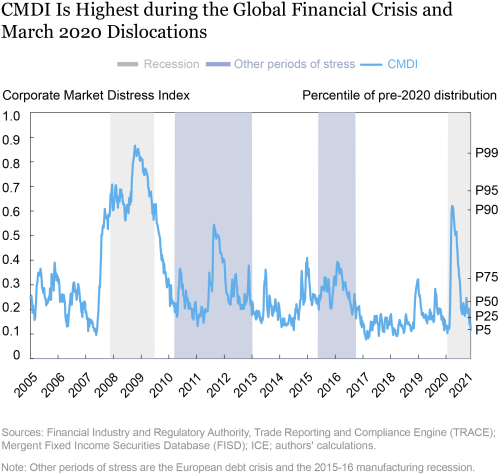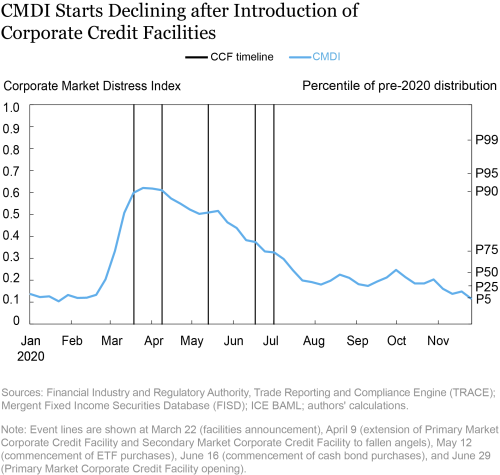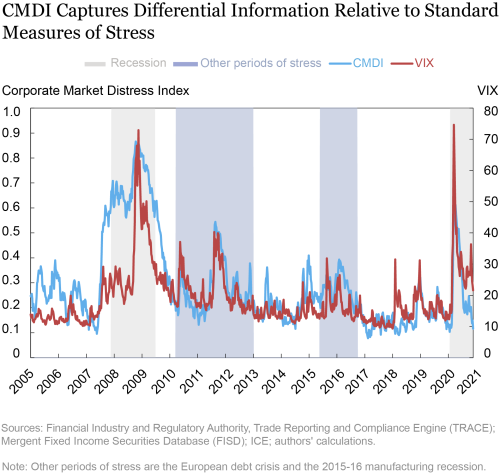With more than $10.4 trillion outstanding as of Q3:2020, the U.S. corporate bond market is a significant source of funding for most large U.S. corporations. While prior literature offers a variety of measures to capture different aspects of corporate bond market functioning, there is little consensus on how to use those measures to identify periods of distress in the market as a whole. In this post, we describe the U.S. Corporate Bond Market Distress Index (CMDI), which offers a single measure to quantify joint dislocations in the primary and secondary corporate bond markets. As detailed in a new working paper, the index provides more salient information about the state of the corporate bond market relative to common measures of financial stress, thereby more accurately identifying periods of widespread dislocation in the market.
Measuring Corporate Bond Market Functioning with the Corporate Bond Market Distress Index
The CMDI aggregates measures of corporate bond market functioning—in both primary and secondary markets—identified in the academic literature. We quantify dislocations from a “preponderance of metrics” perspective, ensuring that no single statistic drives the measure. Primary market measures are derived using data from the Mergent Fixed Income Securities Database (FISD) and include data on issuance volumes and primary market pricing as well as issuer characteristics. For the secondary market, we exploit the trading data available through the Financial Industry and Regulatory Authority’s Trade Reporting and Compliance Engine (TRACE) and include measures that reflect both the central tendencies, and other aspects of the distributions, of volume, liquidity, nontraded bonds, spreads, and default-adjusted spreads. We calculate the index weekly beginning in 2005, using data that would be available in real time.
Combining Many Different Measures into a Single Index
We adapt the methodology of the Composite Indicator of Systemic Stress (CISS) and apply it to the systematic distress of the bond market rather than of the economy. The intuition is to use portfolio theory to optimally combine measures reflecting different facets of dislocation. More specifically, we group standardized metrics into subcategories by the type of information they capture and, for each subcategory, construct a category-specific sub-index as the equal-weighted average of the standardized constituent series. This method produces an index that is more robust than a simple average because it does not overweight subcategories for which we have more measures. Finally, we combine the sub-indexes using time-varying correlation weights, corresponding to an “optimal” portfolio allocation interpretation of the index. The sign and magnitude of the correlations between subcomponents change over time, suggesting that a time-varying approach is particularly valuable. Although each individual sub-index is noisy, the combined index is not.
Aren’t Prices the Best Measure of Market Distress?
Since we expect bond prices to fall and interest rates to rise when risk increases, a price-based measure would not be the best way to assess market functioning; price changes are consistent with functioning markets when risk and risk tolerance change. Instead, several principles guide the construction of the index. First, while information on prices and price volatility is included, these measures do not drive the index. Second, market liquidity—both in the primary market, capturing the ability of issuers to issue new debt, and in the secondary market, capturing the ability of market participants on both sides of the market to transact—plays a key role in the index. Third, the standardized metrics take into account the real-time historical properties of market conditions, so that the index can be back-tested and measured in a historical context.
The CMDI Captures Key Episodes of Market Dysfunction
The chart below plots the time series of the CMDI. The index peaks in the fall of 2008 and remains elevated beyond the end of the Great Recession (first gray shaded area). The CMDI then has a local peak at the height of the European debt crisis (first purple shaded area), and then a smaller peak in the middle of the 2015-16 manufacturing recession (second purple shaded area). The final pre-2020 peak is at the end of 2018, corresponding to market turmoil in both equity and credit markets, which was ameliorated after the Federal Open Market Committee paused its cycle of interest rate increases. The right-hand scale of the chart shows the percentiles of the pre-2020 CMDI distribution, highlighting that the levels of corporate bond market dislocation that occurred in March 2020 were only ever previously observed during the global financial crisis.

We zoom in on the more recent period in the next chart. Prior to the start of the COVID-19-related disruptions to asset markets in March 2020, the CMDI was noticeably below the pre-2020 historical median. In the week ending March 21, the CMDI rose above the historical 90th percentile—based on data prior to January 2020—for the first time since the financial crisis. The announcement of Federal Reserve interventions on March 22 halted any further increases in the level of the CMDI, but the index remained above this historical benchmark until the week ending April 11, which coincided with the announced expansion of the Corporate Credit Facilities in both size and scope. Over the course of April and May, the CMDI continued its gradual decline and was only modestly above the historical median by the end of July 2020. The start of purchases of individual bonds on June 16 coincided with the index dropping below the historical 75th percentile for the first time since March. This is consistent with the larger impact of cash bond purchases on secondary market pricing and liquidity documented in a previous blog post.

How Does the CMDI Compare to Measures of Investor Risk Aversion?
The paper compares the CMDI to measures of investor risk aversion, corporate borrowing conditions, and broad indicators of financial conditions. In general, the CMDI and measures of financial market stress are positively correlated, reflecting the fact that market functioning often deteriorates across many markets at the same time. For example, the CMDI is high when measures of market participants’ overall risk aversion are high. As shown in the chart below, the CMDI is highly correlated (74 percent correlation in levels) with the Chicago Board Options Exchange’s CBOE Volatility Index (VIX). However, the CMDI provides distinct information. For example, while the CMDI increased already in the summer of 2007, the sharp increases in the VIX during the financial crisis only materialized in the fall of 2008. On the other hand, the VIX spiked at month-end January 2018, reportedly because of an unwinding of “short volatility” trades. While this spike represented equity market stress, the CMDI remained flat during the same period, highlighting that the CMDI measures corporate bond market distress in particular, rather than stress of related markets.

A Single Measure Is Useful but Needs to Be Used Carefully
Each of the individual metrics included in the CMDI provide important data on corporate bond market functioning. Primary market issuance directly measures the extent to which companies can fund themselves, but the metric is lumpy and idiosyncratic. Secondary market trading data and the distribution of different measures are available each day, but they depend on which bonds trade. With the CMDI, we provide a way to optimally combine these measures, producing a useful summary measure. However, it is always important to also monitor the underlying components, as each tells a different story about the way in which markets may be showing signs of distress.
 Nina Boyarchenko is a research officer in the Federal Reserve Bank of New York’s Research and Statistics Group.
Nina Boyarchenko is a research officer in the Federal Reserve Bank of New York’s Research and Statistics Group.
 Richard Crump is a vice president in the Bank’s Research and Statistics Group.
Richard Crump is a vice president in the Bank’s Research and Statistics Group.
 Anna Kovner is the policy leader for financial stability in the Federal Reserve Bank of New York’s Research and Statistics Group.
Anna Kovner is the policy leader for financial stability in the Federal Reserve Bank of New York’s Research and Statistics Group.
 Or Shachar is a senior economist in the Bank’s Research and Statistics Group.
Or Shachar is a senior economist in the Bank’s Research and Statistics Group.
How to cite this post:
Nina Boyarchenko, Richard Crump, Anna Kovner, and Or Shachar, “Measuring the Forest through the Trees: The Corporate Bond Market Distress Index,” Federal Reserve Bank of New York Liberty Street Economics, February 22, 2021, https://libertystreeteconomics.newyorkfed.org/2021/02/measuring-the-forest-through-the-trees-the-corporate-bond-market-distress-index.html.
Related Reading
The Impact of the Corporate Credit Facilities
Disclaimer
The views expressed in this post are those of the author and do not necessarily reflect the position of the Federal Reserve Bank of New York or the Federal Reserve System. Any errors or omissions are the responsibility of the author.











 RSS Feed
RSS Feed Follow Liberty Street Economics
Follow Liberty Street Economics
Caitlin Dannhauser of Villanova U. and Saeid Hoseinzade of Suffolk U. have written a few papers on the effect of market/credit shocks on corporate bond mutual funds and ETFs. They generally conclude that for “normal” credit shocks the fears that a liquidity shock will affect those funds are usually overstated , but that may not be the case for more prolonged shocks where the proportion of illiquid corporate bonds rises beyond some critical level. Interesting reading.
The economics of stock vs. flow is startling. The expansion of the nonbanks does not reduce the size of the payment’s system. Saved bank deposits that are transferred to the nonbanks are not transferred out of the banks; only their ownership is transferred. The reverse process, which is called “disintermediation”, has the opposite effect: the intermediaries shrink in size, but the size of the payment’s system remains the same (like the Sept. 18, 2008 draw down in money market accounts). The solution to subpar economic growth is to drive the banks out of the savings business (which would make them more profitable).
Stress is related to bank / non-bank funding. The Sept. 2019 repo crisis was due to an interest rate inversion. I.e., nonbank lending results in an increase in the supply of loan funds, but not the supply of money, a velocity relationship. The remuneration rate provides the payment’s system with a preferential interest rate differential in favor of the banks (as opposed to Reg. Q ceilings, between 1966 and 1986, which provided an interest rate differential in favor of the thrifts, in the thrifts borrowing short to lend longer savings/investment paradigm). The FED’s policy is currently the tightest since Oct. 2008. The remuneration rate inverts the money market, and all other rates, up to five years out on the wholesale funding yield curve.